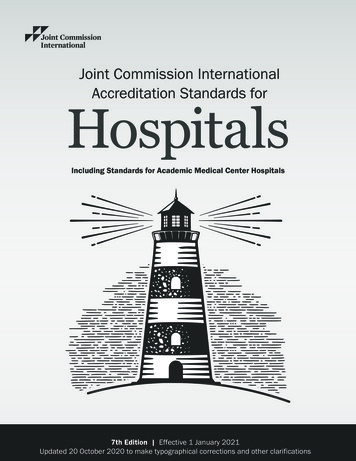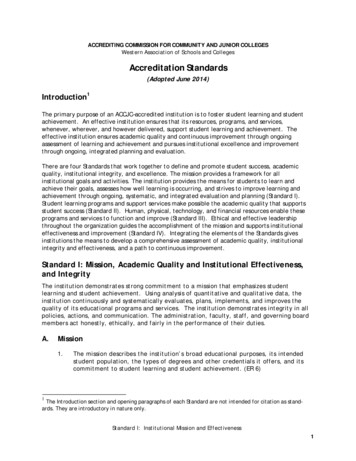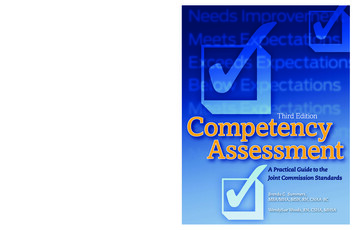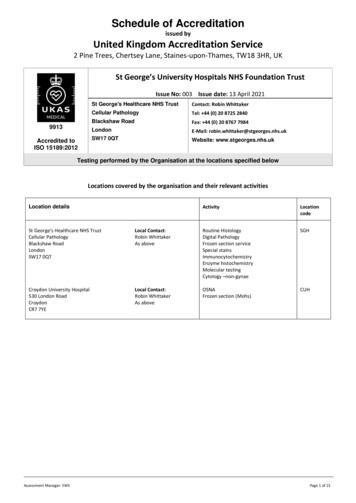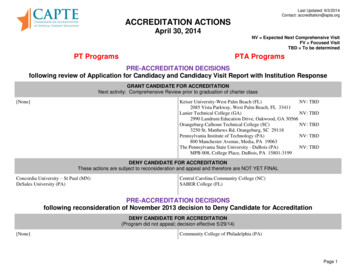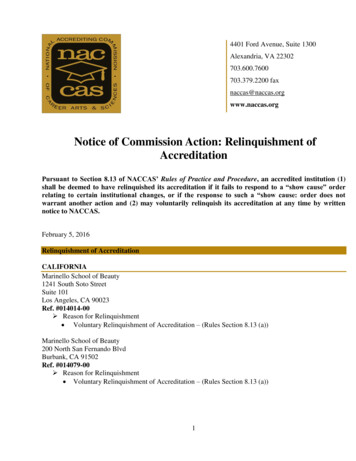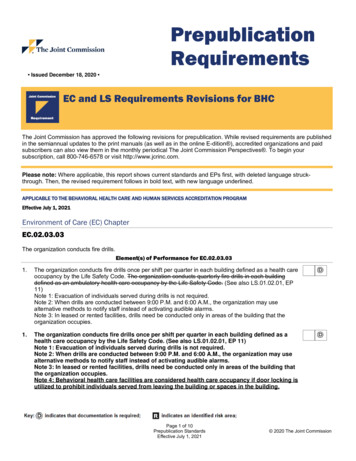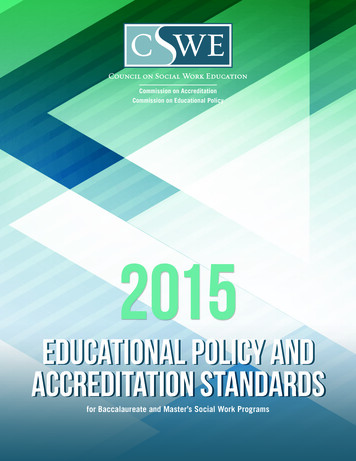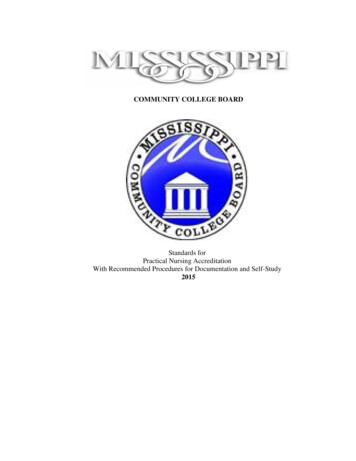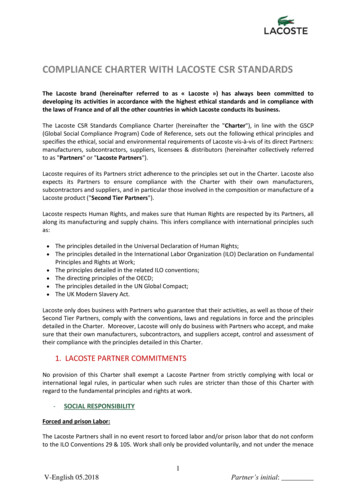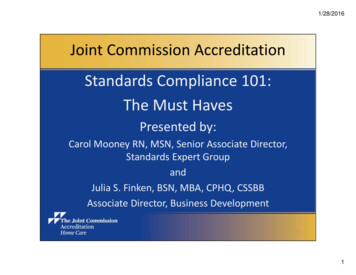
Transcription
1/28/2016Joint Commission AccreditationStandards Compliance 101:The Must HavesPresented by:Carol Mooney RN, MSN, Senior Associate Director,Standards Expert GroupandJulia S. Finken, BSN, MBA, CPHQ, CSSBBAssociate Director, Business Development11
1/28/2016GoToWebinar HousekeepingYour ParticipationJoin audio: Choose “Mic & Speakers” to useVoIP Choose “Telephone” and dial usingthe information providedQuestions/Comments: Submit questions and comments viathe Questions panel.Note: Today’s presentation is beingrecorded and will be posted on theJoint Commission website.22
1/28/2016Joint Commission AccreditationStandards Compliance 101:The Must HavesPresented by:Carol Mooney RN, MSN, Senior Associate Director,Standards Expert GroupandJulia S. Finken, BSN, MBA, CPHQ, CSSBBAssociate Director, Business Development33
1/28/2016Objectives An overview of our eligibility requirements includingservices and patient/client volumes Strategies to avoid the most common issues that can delayyour on‐site survey Standards that may trigger a follow‐up survey if you’refound ‘non‐compliant’44
1/28/2016Eligibility Requirements Satisfy your state law and licensing requirements Company is operational and providing care Traditional accreditation and DMEPOS recognition Must have served 10 clients/patients, minimum of 2 active attime of survey Home health deemed status Must have served 10 skilled patients, minimum of 7 active attime of survey Hospice deemed status Must have served 5 patients, minimum of 3 active at thetime of survey55
1/28/2016Strategies to Prevent Survey Delays Ideally, submit your application 9 months prior toyour desired completed accreditation goal date, butno less than 5 months prior to your desiredcompleted accreditation goal date Ensure requisite number of patients are active atthe time of survey Do not attest to your ready date unless you aretruly ready Ensure the “right” people are on‐site for the survey66
1/28/2016Top Standards Out of Compliance ThatMay Trigger an On‐Site Follow‐up SurveyStandardPercentage of Surveys with C.01.04.0130.2%IC.02.04.0130.2%77
1/28/2016Provision of Care, Treatment andServices88
1/28/2016PC.02.01.03 The organization provides care, treatment, or servicesin accordance with orders or prescriptions, as required by lawand regulation. Chief areas of non‐compliance Providing care without a physician’s order Prescribed frequency of visits not followed Aides provide services not listed on care plan74%Aha! You’re only looking at the outcome if you’re justauditing the health record and comparing doctor’s ordersto documented care in the notes.99
1/28/2016Applied Strategy Drill down to discover what care is provided without orders Use a Pareto chart to find out how to get the greatest impact Observe the process used to obtain and record orders Verbal order read‐back How do staff document a physician’s order? Implement self‐accountability for visit frequency Use visual cues to alarm user of over/under usage Qualitatively evaluate performance Evaluate the process used to supervise staff Written process, observe behavior, trace the activity1010
1/28/2016PC.01.02.01 The organization assesses and reassesses its patients. Chief areas of non‐compliance Following orders and organization policy Missing some assessments components Lack of complete reassessments or not timely42%1111
1/28/2016Applied Strategy Prompts and remindersStandardization of ordersDefined policyStaff trainingAutomation1212
1/28/2016Record of Care, Treatment,and Services1313
1/28/2016RC.02.01.01 The patient record contains information that reflectsthe patient’s care, treatment, or services. Chief areas of non‐compliance Missing documentation Delayed filing and records management Delayed submission of documents from subcontractors65%1414
1/28/2016Applied Strategy Automate the documentation submission process Monitor and measure the flow of information in andout of the organization Effectively manage contract services: Awareness: Written in contract Compliance: Monitor and measure Transparency: Report on outcomes1515
1/28/2016Human Resources1616
1/28/2016HR.01.06.01 Staff are competent to perform their responsibilities. Chief areas of non‐compliance No defined competencies Lack methods of assessment Competencies are not done upon hire or per policy56%1717
1/28/2016Applied Strategy Evaluate the process used to determine thecompetency of staff Define the required competencies necessary to performthe position duties Determine the most effective method to evaluate theidentified competency Automate the process used to notify supervisors acompetency is due Define and implement remediation activities necessaryto restore competency when performance isunsatisfactory1818
1/28/2016HR.01.02.05 The organization verifies staff qualifications. Chief areas of non‐compliance Lack of primary source verification upon hire andexpiration of license Verification and documentation of experience andeducation Criminal background checks Health screenings documentation40%1919
1/28/2016Applied Strategy Evaluate the process used to obtain verification Automate the process used to notify staff whenverification nears expiration Embed the process for criminal background checksand health screenings as standard work duringorientation2020
1/28/2016Infection Surveillance, Prevention andControl2121
1/28/2016IC.01.03.01 The organization plans for preventing and controllinginfections. Chief areas of non‐compliance Plans not specific to location, community, andpopulation Plans that do not address specific care and services Analysis of surveillance activities and data37%2222
1/28/2016Applied Strategy Evaluate specific geographic area and community forunique risks related to infection control Look at patient population served – young or elderly Contact local health department Evaluate the specific services provided and potentialrisk to patients2323
1/28/2016IC.01.04.01 Based on the identified risks, the organization sets goalsto minimize the possibility of spreading infections.Note: See NPSG.07.01.01 for hand hygiene guidelines. Chief areas of non‐compliance There are no written specific goalsGoals are not measurableGoals are not specific to services providedHand hygiene goals set to evaluate improvement30%2424
1/28/2016Applied Strategy Evaluate the services and care to determine risks Establish clear priorities based upon risks identified Address any procedures and equipment used incare2525
1/28/2016IC.02.01.01 The organization implements the infectionprevention and control activities it has planned. Chief areas of non‐compliance Breaks in hand hygiene technique Not providing PPE or hand hygiene supplies Collection of surveillance activities, aggregation, andanalysis to reduce risk of infections42%2626
1/28/2016Applied Strategy Evaluate the effectiveness of the process used todetermine compliance w/hand hygiene Written program clearly defines expectations PPE is readily available and management is unwavering inits commitment to use Data collection is routine, analysis occurs frequently andreports are posted in real time2727
1/28/2016Key Resource to help you CDC Morbidity and Mortality Weekly Report forHand Hygiene Discusses Hand Hygiene practices among HCW’s Types of activities resulting in cross contamination Efficacy of plain soap, antiseptic soap/detergent andalcohols Methods used to promote improved Hand hygiene2828
1/28/2016IC.02.04.01 The organization offers vaccination against influenza tolicensed independent practitioners and staff. Chief areas of non‐compliance No credible plan for influenza vaccination program No written plan No data collected to determine reasonable compliance goals No information available to support the value of the program30%2929
1/28/2016Applied Strategy Use the CDC website for information on influenzavaccinations for all staff, contract staff and LIP’s Collect data between October and March on whohas been vaccinated, regardless of where ithappened Check the National Quality Forum (NQF) websitefor information that supports the value of theseprograms3030
1/28/2016Useful resources for you: www.cdc.gov y/InfectionControl/H1N1 podcast.htm http://www.quality forum.org/WorkArea www.who.int3131
1/28/2016National Patient Safety Goals3232
1/28/2016NPSG.15.02.01: Identify risks associated with home oxygen therapysuch as home fires. Chief areas of non‐compliance Meaningful risk assessmentRisk based re‐assessmentRelevant patient educationAssess level of compliance with interventionsImplement strategies to improve compliance35%3333
1/28/2016Applied Strategy Use uniform messaging verbally and in writingUse a defined process to manage at risk individualsAlways notify the prescriber/payer of at risk behaviorsTeach staff how to document observations andresponsesDo a root cause analysis on any near missConsider the use of a contract with at riskpatients/clientsEstablish inter‐organization safety partnershipsEmbed accountability into job descriptions3434
1/28/2016Avoid these popular MYTHS: We can’t be accountable for a non‐compliant patientIt’s none of our business, we’re not the DME companyHe/she is a hospice patient, give him/her what they wantIt’s their home and the patient is responsibleJust don’t document that you saw the at risk behaviorJust keep documented that you re‐educated the patientStaff already know how to handle these patientsThe doctor(s) don’t want to hear about itThe insurance company doesn’t careHe/she is very careful, it won’t happen to them3535
1/28/2016Free resources to support your ongoingeffortsTake 5 Podcast: Oxygen SafetyBlog post: 10 Ways to Prevent Fires in the HomeVisit www.jointcommission.org and type “oxygen safety” inthe search bar to find these and other helpful resourcesCurrently accredited providers can access our LeadingPractices Library (found on your extranet site) for additionalresources on this and other topics3636
1/28/2016http://www.nfpa.org/3737
1/28/2016Other resource sites3838
1/28/2016Other resource sites3939
1/28/2016Resources Standards ExpertsAccount ExecutiveLeading Practice LibraryPortals HAI Transitions of Care High Reliability Center for TransformingHealthcare (Targeted SolutionTools) Electronic Prep Tool (ICM Tool) Standards Booster Pak Speak Up Program Free WebinarsFree Webinar ReplaysFree CEU CoursesPodcastsSpeakers BureauSurvey Activity GuidesTracer MethodologyFAQsSurveyorPerspectivesHome Care BulletinE‐dition4040
1/28/2016Important TJC ContactsIf you have a question about .GETTING STARTED: How to get started The overall accreditation process The cost of accreditation How to get a free trial of the standards How to request an applicationMANAGING THE ACCREDITATION PROCESS: Completing the application Scheduling a survey date Specific issues related to ongoingPlease contact .THE BUSINESS DEVELOPMENT TEAM:Call: 630-792-5070Email: homecare@jointcommission.orgWebsite: www.jointcommission.orgAN ACCOUNT EXECUTIVE:Call: 630-792-3007accreditationOUR STANDARDS: Complying with specific standardsTHE STANDARDS HELP DESK:Call: 630-792-5900, Option 6Website: www.jointcommission.org/StandardsMANUALS, EDUCATION AND TRAINING: Obtaining standards manual Registering for a Joint Commissioneducation program Staff training resourcesJOINT COMMISSION RESOURCES (JCR):Call: 877-223-6866Email: jcrcustomerservice@pbd.comWebsite: www.jcrinc.com4141
1/28/2016Time for Your Questions!4242
1/28/2016Submitting Your QuestionsAttendee Participation Please continue to submit yourtext questions and commentsusing the Questions PanelNote: Today’s presentation is beingrecorded and will be posted on theJoint Commission website.4343
1/28/2016Home Care Team ContactsJoint Commission Home Care ProgramHelp Desk: 630-792-5070 or g/accreditation/home care.aspxMargherita LabsonBSN, MSHSA, CPHQ, CCM, CGBExecutive Director630-792-5284 ormlabson@jointcommission.orgJulia FinkenBSN, MBA, CPHQ, CSSBBAssociate Director630-792-5283 orjfinken@jointcommission.orgBrenda Lamberti, BSSenior Business DevelopmentSpecialist630-792-5252 orblamberti@jointcommission.orgMonnette GeronimoBusiness Development Specialist630-792-5251 ormgeronimo@jointcommission.orgAccount ExecutiveStandards Interpretation Help Desk: 630‐792‐5900, option 3Joint Commission Resources: 877‐223‐6866 or www.jcrinc.com4444
1/28/2016Follow us and join us @TJCHomeCareThe Joint Commission’s Home Care accreditation---the-joint-commissionJoin us for our next webinar in this seriesStandards Compliance 201: Strategies for Complyingwith Challenging StandardsRegister today inar RegistrationLP.html4545
Important TJC Contacts . Joint Commission Home Care Program BSN, MBA, CPHQ, CSSBB. The Joint Commission’s Home Care Program. Microsoft PowerPoint - F
